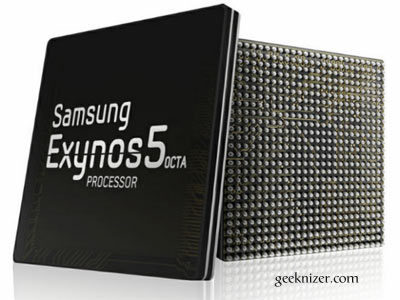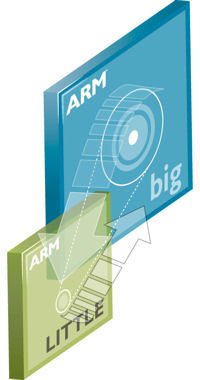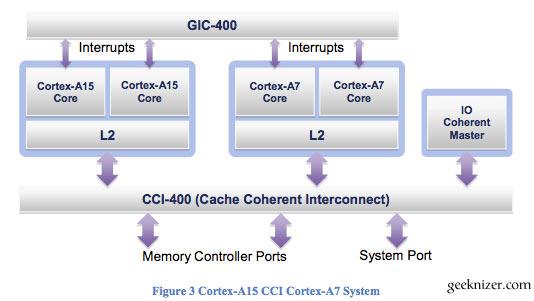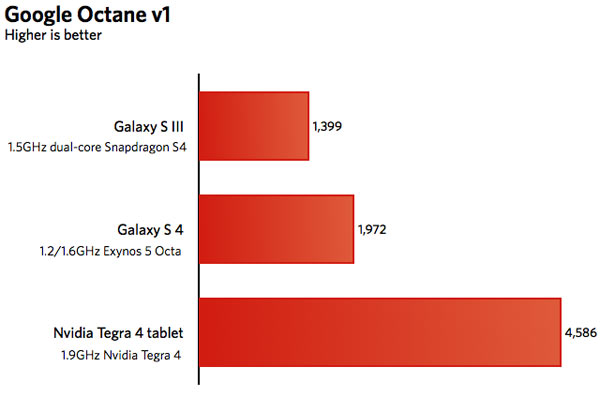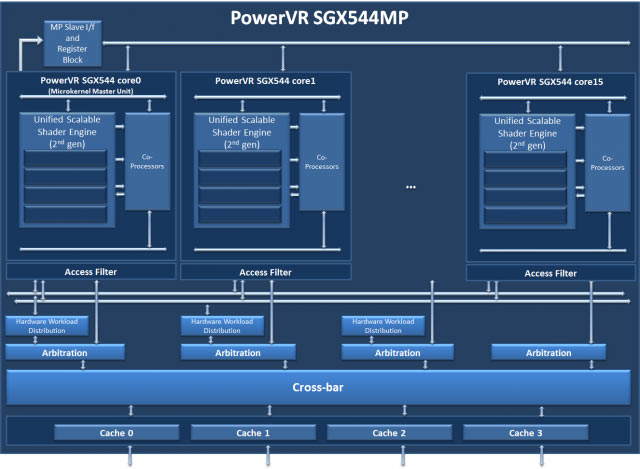Samsung had announced two versions of Galaxy S4, one with Qualcomm Snapdragon 600 1.9Ghz quad-core and the other one Exynos 5 Octa-core. Quad-core will be targeted for U.S. and other countries that have 4G LTE, while latter Exynos 5 quad will be designed for the international version.
Inside Exynos 5 Octa
So what is inside the hottest processor Exynos 5 Octa SoC (system-on-a-chip)? As the name suggests, its a 8-core processor. But unlike what one might think, not all 8-cores can be powered at the same time.
Exynos 5 consists of four high-powered 28nm Cortex-A15s and four slower Cortex-A7s. This design was finalized to tackle two buzzwords in the mobile computing: Performance and battery life.
Why this move?
Samsung had faced one issue with Exynos 5 Dual (ARM15) in Nexus 10: Battery Drain. Its a really powerful processor but try using it for gaming and your battery would drain in 1/5th the normal time (couple of minutes). Reason was Exynos 5 could consume upto 4.5-5.5watts of power during graphics intensive tasks like Gaming. This level of battery consumption is unseen in the smartphone/Tablet mobile industry, where we really have limited battery juice.
Traditionally, chip manufacturers had handled this by clocking the same chip at different clock speeds. e.g. when mobile device is in idle state a 1.6ghz quad-core will be powered down to 200Mhz to save battery juice. Similarly, on need basis it can be clocked to a higher clockrate to achieve desired performance. Exynos 5 Octa follows a new approach using a CPU configuration that ARM calls “big.LITTLE”
Samsung has used Big.LITTLE configuration with two distinct CPU cores: one larger and faster (For Galaxy S4, a Cortex-A15 running at 1.2GHz) and one that is smaller and more power-efficient (a Cortex-A7 running at 1.6GHz). Both of these are ARM processors and hence its obvious that there is no difference in instruction set.
By using multiple processors that are developed for different energy and performance budgets, big.LITTLE provides optimum performance and maximum efficiency. The first big.LITTLEsolutions will pair the ARM Cortex-A15 processor with the ARM Cortex-A7 processor. This will be followed by a roadmap of new Cortex processors that build on big.LITTLE making it an important innovation for future mobile devices.
If you want to think big, think big.LITTLE – technology that enables the next generation of mobile gaming, bigger brighter screens and longer mobile battery life.
The slower ARM7 core is designed to handle basic tasks like browsing, music, email, etc. This gives extended battery life and decent performance. But for complex tasks like Gaming, HD videos, etc, it switches to Cortex A15 cores, which are really performing and power hungry.
The switching between cores is instantaneous, of the order of few nanoseconds. In other words, this almost as fast as switching the clock of a core. Firmware on the device can abstract this from the OS level and hence this configuration can be used on any OS viz. Android, Windows Phones.
From the ARM’s whitepaper:
A key part of the design is the full coherency between Cortex-A15 and Cortex-A7as well as IO coherency for components such as a GPU. Through optimizations around the transaction characteristics of Cortex-A15 and Cortex-A7 as well as by considering the paths to main memory and thesystem, a single solution is offered with the highest possible performance.
Figure 3 Cortex-A15 CCI Cortex-A7 SystemAnother element of the big.LITTLE system is a shared Generic Interrupt Controller (GIC-400). As well as being able to distribute up to 480-interrupts to Cortex-A15 and Cortex-A7, the programmable nature of the GIC-400 allows interrupts to be migrated between any cores in the Cortex-A15 or Cortex-A7 clusters.From the perspective of trace and debug, both Cortex-A15 and Cortex-A7 offer trace solutions and are both compliant with the Debug v7.1 architecture.
Full support for big.LITTLE debug and trace is provided through CoreSight™ SoC.A final point to consider is that a big.LITTLE system incorporating Cortex-A15, Cortex-A7, CCI-400 and the GIC-400 is optimal for all big.LITTLE use-models. There is no configurable feature or optimization that favors a particular use-model. However, to reduce software complexity in the big.LITTLE task migration use model it is recommended that the same number of cores be implemented in the Cortex-A15cluster and Cortex-A7 cluster.
Power saving cores isn’t new
Nvidia used 5-cores in Tegra 3, where 5th core was power saving core, which kicked in and saved battery drain of other 4-cores, when phone is performing light weight tasks. Big.LITTLE is a better approach, as per ARM. But we’ll have to wait and see the authenticity of the claim.
ARM’s big.LITTLE has two variants, first one called “big.LITTLE MP”, where Cortex-A7 and A15 cores can be active at the same time. Second one is which Samsung is using, powering down one combo.
Exynos 5 vs. Tegra 4 Performance (Benchmarks)
From what we’ve known from Nvidia’s team, Snapdragon 600 or 800 doesnot match the performance of Tegra 4 CPU or GPU. But What about Exynos 5’s ARM15 cores?
Exynos 5 Octa might be the closest SoC to Tegra 4. But as per the benchmarks shown from Tegra 4 reference tablet (prototype), Exynos 5 Octa lags behind.
Benchmarks are not exactly to be trusted since there is a gap. Exynos 5’s ARM15 cores are clocked at 1.2Ghz and Tegra 4 A15 is 1.9Ghz. This can explain the performance difference seen in the benchmarks.
Exynos 5 PowerVR SGX544MP GPU Performance
PowerVR SGX 544MP3 is a proven graphics processor, which has shown its true performance in Apple’s A6’s PowerVR SGX 543MP3 featured in iPad 4th generation. Samsung has moved away from their very own Mali GPUs, which were also good, but not as great at PowerVR SGXs.
The 544MP3 and 543MP3 are almost the same with 544MP3 supporting DirectX 9 and OpenGL 2.1. The clear advantage is that Samsung can use 544MP3 chips with Windows Phone 8 devices to run high-end games on Windows platforms.
Snapdragon 600 for North-America
American version of the phone will instead use a 1.9GHz quad-core Snapdragon 600 SoC.
Snapdragon 600 1.9Ghz is not the top notch processor you’ll find in the market, but its an industry trend for smartphones with 4G LTE connectivity. With Nvidia working to push 4G LTE in Tegra 4, we could start seeing some Tegra 4 based 4G LTE phones, but that would take some time. Tegra 4 has a dedicated 4G LTE soft-modem based on Icera i500 that can do wonders to 4G conenctivity. Q3 2013 is when we can start seeing such devices.
We write latest and greatest in Tech Guides, Apple, iPhone, Tablets, Android, Open Source, Latest in Tech, subscribe to us @geeknizer on Twitter OR Google+ or on Facebook Fanpage
loading...
loading...

